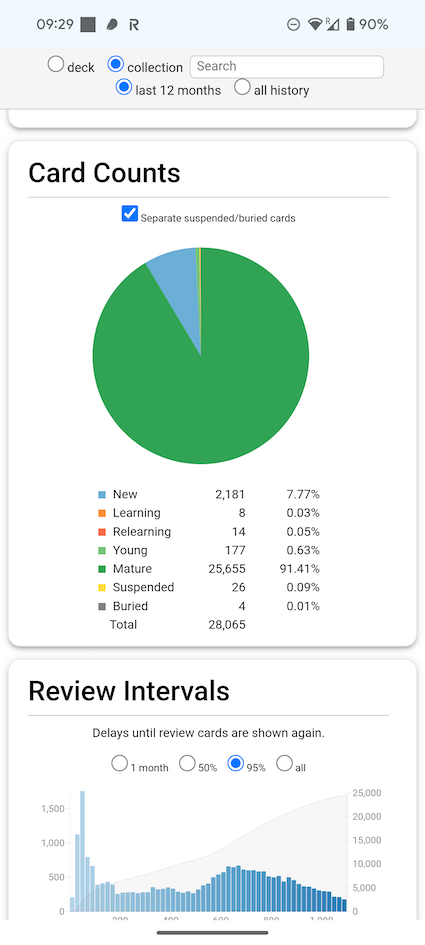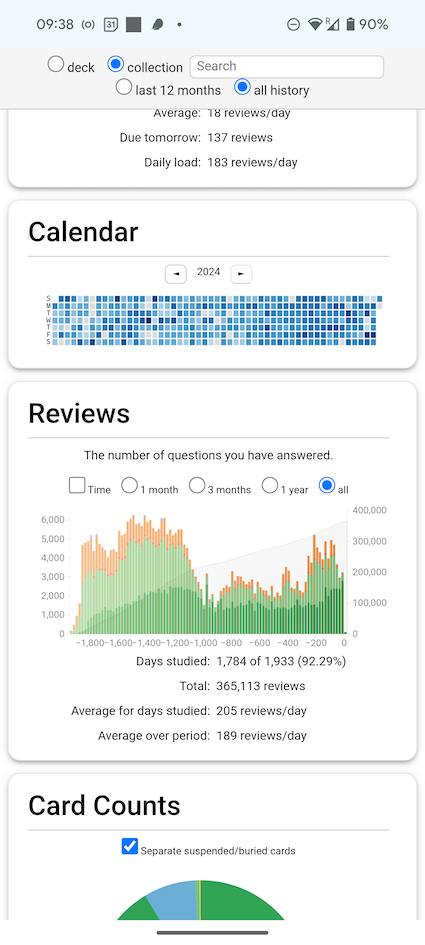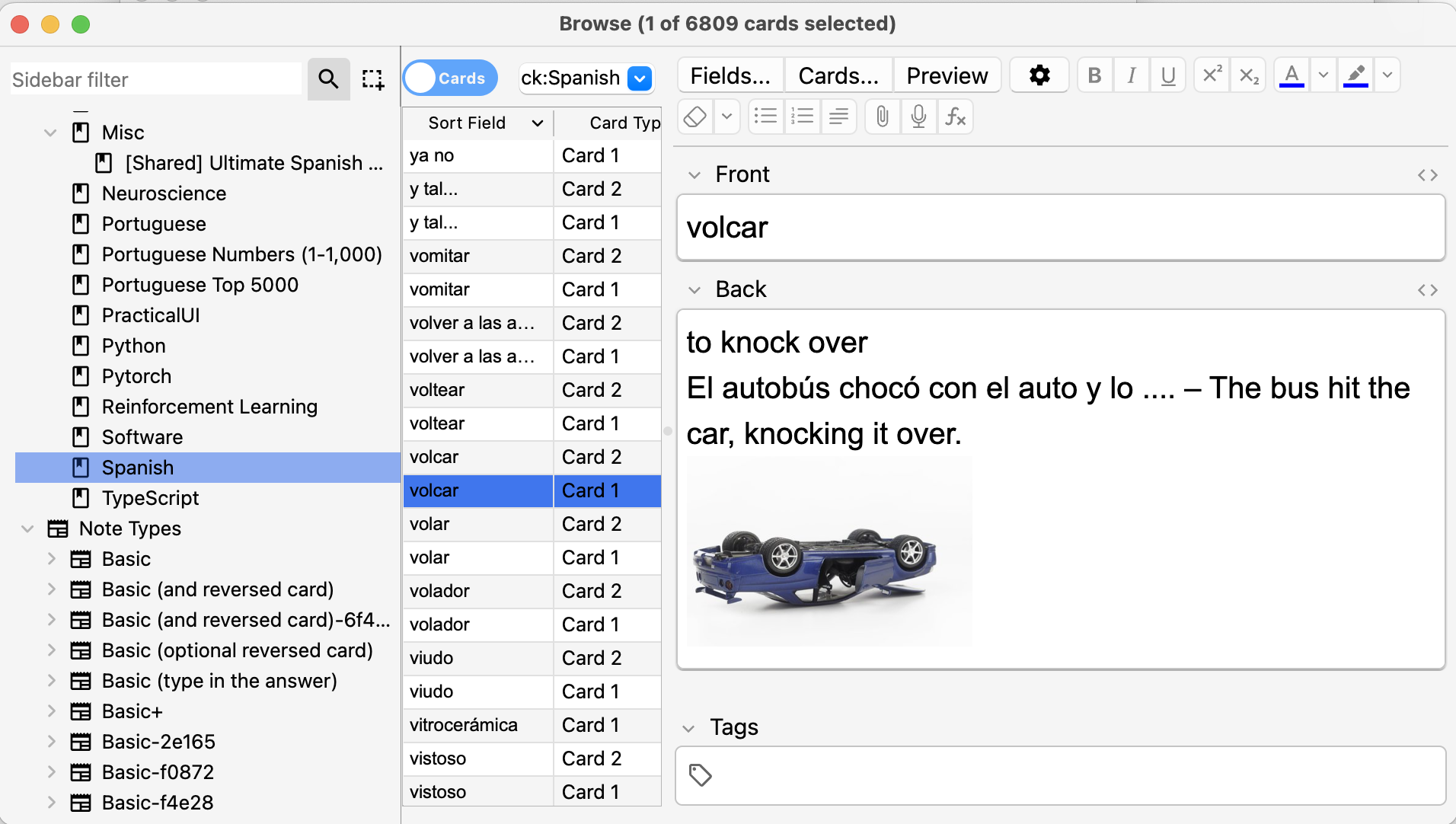How I Use Anki to Learn Languages Effectively

Justyna Ilczuk, 2025-05-10
In this post I will share with you my tips on using anki to learn languages after using it consistently for more than 5 years.
Why should you trust me?
I'm not a world-renowned expert, but I’ve walked the walk. I started using Anki in 2020 and have been reviewing cards nearly every day since — averaging over 200 reviews a day.
Check out these screenshots.
Stats about my cards, 28k and counting! 25k+ of them mature!

My reviews over the years:

I've used Anki to learn thousands of words in Spanish and Portuguese, and also to study topics like neuroscience, math, and machine learning. It’s one of the few tools that’s stayed with me year after year.
Tips for Adding Cards
I use the Anki desktop app to add cards — it’s just more flexible. The mobile version is a bit awkward for editing, and while AnkiWeb would be convenient, it lacks the features I rely on - like adding images.
I usually add cards manually. I haven’t found a tool that creates them exactly the way I want yet, and for me, quality matters more than speed. But at the same time, I don't worry to make it perfect, I can always edit the card later on if I want to improve it.
For each word I learn, I typically create two cards: a standard one and a reversed version. Most often, the front is just the Spanish word, and the back includes:
- the English meaning,
- a context sentence with the target word blanked out,
- and an image if I can find a good one.
For example:
Front: volcar
Back: to knock over
El autobús chocó con el auto y lo .... – The bus hit the car, knocking it over.
(+ picture of an overturned car)

As for the images — I keep it simple. If I’m learning a concrete noun like bucket, I’ll usually just grab the image straight from the dictionary website. For Spanish, I use SpanishDict, which often has useful pictures alongside the definition.
For languages like Portuguese, I also add pronunciation. If I can’t find good native audio online, I generate it myself using Edge-TTS, which gives you pretty natural-sounding voices. Audio makes a big difference for tricky words — especially for building listening intuition and not just reading skills.
Sometimes a word has multiple meanings — I usually list them all unless one is super obscure.
If there are several words that could match the same definition, I’ll add them as synonyms or give myself a hint like "starts with o” to avoid confusion on the back of the card.
If something is regional, I’ll also make a note of it — like [Mexico] or [Spain] — to make sure that I am aware of that. I had some Spaniards complain to me when I would use a word that is more common in Latin America Spanish and I had some Mexicans not knowing words used in Spain, so it's important to be aware where the words are used when you learn them.
Tips for Reviews
I do my Anki reviews every morning with my coffee, before breakfast, on my phone. Usually while doing some passive stretches. Yes, I know it looks hilarious — but it’s so efficient, and honestly, who cares? It’s become part of my routine, and I always need to do more stretching and more anki reviews, so why not pair them together. I usually do 20 cards per one stretch to be super specific 😂.
I try not to leave everything until the last moment. If I get a chance during the day, I’ll squeeze in an extra 10 minutes here and there just to chip away at the backlog. I also set my Anki “day” to end at 12:00 PM (midday). That way, I don’t have pressure hanging over me in the evening — I aim to finish my reviews while I’m still fresh. I can do some cards in the evening if I want, but this structure helps me stay consistent without getting overwhelmed.
I’ve experimented a little with custom settings, but honestly, the default Anki algorithm works well for me. I trust the spaced repetition system to do its job. The biggest win isn’t tweaking the intervals — it’s just showing up every day.
I also make a habit of editing cards during reviews. If something feels off — maybe the sentence is awkward, or the card doesn’t make sense — I’ll fix it immediately. And if I keep recalling a different word than the one I intended, I’ll note that on the card too. That helps prevent future confusion.
When I’m learning multiple languages, I’m careful not to review them back-to-back. I don’t mind mixing Spanish decks, like vocab and conjugation, but I try to leave some space between Spanish and Portuguese. Otherwise, I start mixing them up — especially with lookalike words.
Tips for Learning New Cards
I usually stick with the default setting of 20 new cards per day per deck — but since I use multiple decks, this can add up quickly. For decks that feel more intense or time-consuming, I drop it down to 6 new cards per day.
Sometimes I would feel like I can do much more than 20, but this can backfire. For each card you learn, you will get a review and not just once, it will be repeating over time. And that can pile up quickly. Better to learn a bit slower not to be hammered by the reviews later, trust me.
When life gets hectic and language learning isn't a priority, I switch to the 6-a-day mode across the board. That way, I still learn something new, but I don't overload myself with a wave of reviews a few days later.
When I’m learning new cards for language learning, I usually move through them pretty quickly. I’ll say the word out loud a couple of times, glance at the context sentence, maybe imagine a situation where I’d use it — but I don’t try to memorize it perfectly on the spot. I rely on the review system to help it stick over time.
That said, the process of creating the card is already a form of learning. I’m thinking about how to phrase the definition, choosing the right context sentence, maybe adding a picture or audio — and that extra effort helps build familiarity with the word before the reviews even start.
I don’t usually know in advance which cards will be tricky — that only becomes obvious when I keep forgetting the same one over and over. If that happens, it’s a signal to either put in more effort or just edit the card to make it clearer.
Your Own or Community Decks?
Community decks are great for convenience. You don’t need to put in any effort to make them — just hit download and go. And they’re surprisingly effective at force-feeding you vocabulary. Even 10–20 new words per day really adds up over time. Additionally, once you start using a deck, you can edit the cards if something is not right or if you want to improve it. It starts ready made, but you can customize or even delete cards later.
My own cards serve a different purpose: they make sure I don’t forget what I’ve already learned. If I don’t add something to Anki, I probably won’t review it again — and then I’ll forget it. I hate that. So putting in the effort to build my own cards is worth it.
When I make my own decks, I start simple — just an empty deck — and then add cards as I go. Usually, I add them in small batches once I’ve collected a handful of words, maybe 5–10 at a time.
Here’s how it usually works: I’m watching something or reading, and I come across new words. I’ll open dictionary tabs for the ones I want to remember, then later I go through those tabs and turn each one into an Anki card. If I’m out and about and look something up on my phone, I’ll take a screenshot. Later, I scroll through my Google Photos and add cards from the screenshots I took.
It’s not fancy, but it works. And most importantly — it keeps me from forgetting what I learn.
What Type of Content to Use
When it comes to vocab, I start with the most common words. It’s the fastest way to get traction in a new language. After that, most of what I add comes from real-life encounters — words I happen to look up while reading, watching, or listening to something.
In my experience, vocabulary gives the biggest return. Words are where most of the value is. Numbers are also worth learning early — they’re finite, and you’ll need them constantly. Just get them out of the way.
Conjugations, on the other hand… painful. But useful. I use a deck for irregular Spanish verbs and it’s definitely helping, even if it’s one of the most boring parts of my reviews.
I’ve also experimented with set phrases, but I’m not a big fan of drilling them in Anki. I’d rather pick them up naturally through exposure — from books, shows, and conversations. That kind of learning feels more intuitive and sticks better than forcing it through flashcards.
I’ve tried sentence mining, but it felt a bit arbitrary. Sentences can be translated in lots of different ways, and there are millions of possible options. It’s hard to know what’s worth keeping. With vocabulary, the progress is much clearer — there’s a concrete goal, like finishing the 5,000 most common words deck. That kind of structure gives me a stronger sense of achievement. With 5,000 sentences, what exactly have I learned? It’s harder to quantify.
That said, I’m flexible in my own decks. If I come across a sentence or expression that feels worth remembering — maybe it’s funny, elegant, or just useful — I’ll add it.
Final Thoughts
If I had to sum it up, here are the tips that matter most:
- Be consistent. Anki only works if you show up — even 10 minutes a day goes a long way.
- Shared Decks can be gold. The most common words and numbers give the best early return.
- Make your own cards for everything you learn on your own. If you don’t want to forget something, add it.
- Don’t be afraid to tweak. Edit bad cards, give yourself hints, note regional variations.
- Keep it sustainable. Learn fewer new cards during busy periods so future-you won’t suffer.
- Don’t overthink it. You don’t need a perfect system, a card is better than no card, some review is better than none.
The point isn’t to memorize everything instantly. It’s to build a system that helps you remember what you’ve already worked hard to learn. That’s what makes Anki worth it.
